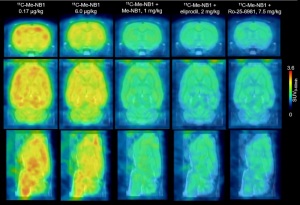by
Lauren Dubinsky, Senior Reporter | April 12, 2018

Rat brain 11C-Me-NB1 PET images
superimposed on an MRI template
Courtesy of ETH Zurich
Swiss and German researchers have created a new PET imaging agent that may help guide and assess treatments for people with neurological diseases such as Alzheimer’s, Parkinson’s and multiple sclerosis.
“Our new PET radioligand, 11C-Me-NB1, binds to the GluN2B sub-units of the iontropic N-methyl-D-aspartate (NMDA) receptor, for which no suitable PET imaging agent exists despite intensive research,” Simon M. Ametamey of the Institute of Pharmaceutical Sciences, ETH Zurich in Switzerland, told HCB News.
The NMDA receptor is known to be involved in physiological processes such as learning and memory as well as various acute and chronic neurodegenerative diseases. The availability of 11C-Me-NB1 would allow researchers to study NMDA expression in healthy and diseased human brains and also help with therapy monitoring.



Ad Statistics
Times Displayed: 365412
Times Visited: 7045 Quality remanufactured Certified Centrifuges at Great prices! Fully warranted and backed by a company you can trust! Call or click for a free quote today! www.Centrifugestore.com 800-457-7576
Ametamey and his team conducted a preclinical study that used 1C-Me-NB1 in live rats to investigate the dose and effectiveness of of a drug called eliprodil that blocks the NMDA GluN2B receptor.
The results, which were published recently in
The Journal of Nuclear Medicine, demonstrated that the PET scans with the new imaging agent successfully showed that the receptors are fully occupied at neuroprotective doses of eliprodil.
“Administering patients with the right dose of the drugs is essential for minimizing side effects, which are often observed with NMDA drugs when not appropriately dosed,” said Ametamey. “Ultimately this would lead to a reduction in attrition rate and improvement in efficacy of drugs targeting the GluN2B sub-units of the NMDA receptor.”
When asked if 11C-Me-NB1 will eventually become the standard for assessing treatments for patients with neurodegenerative diseases, Ametamey said that it’s difficult to determine, since a clinical study hasn’t been conducted yet.
“Nonetheless, I anticipate that this new imaging agent, even if it doesn’t become the standard, will be used as an imaging tool to complement existing imaging agents used for assessing treatment outcomes for patients with Alzheimer’s, Parkinson’s and MS, among others,” he added.

